Share The Road With Cyclists! Tips & facts for drivers & cyclists.
The Sunshine Coast, BC is a mecca for cyclists and cycling tours with its beautiful scenery and winding roads perfect for road bikes, tour bikes, and mountain biking.
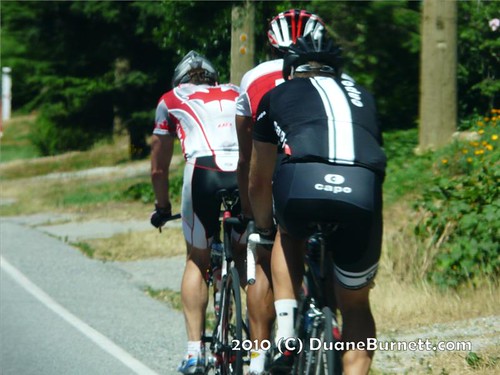
Its extremely close proximity to Vancouver, Canada and magnificent 40 minute ferry ride has a huge magnetic pull on outdoor adventure enthusiasts from the Lower Mainland to come explore what I call the Upper Mainland.
It means drivers need to be super alert, share the road, be patient, and respect that their vehicle is 5,000lbs of machine up against a couple hundred pounds of fragile flesh.
I was traveling down the hill in Selma Park, near Sechelt, BC when I saw a vehicle trying to pass three cyclists.
This particular area of Highway 101 and Selma Park Road has a blind curve plus a hill and is brutal for local drivers to get out of their neighbourhoods so accidents happen along the road quite often.

It reminded me how popular the coast is for tour bikes, cycling, motorcycling and mountain bikers.
As we are trying to support green sustainable transportation, and accidents do happen a lot on Highway 101, and when it involves cyclists we know who wins, I decided to put together this heads up to share the road and include a few safety tips.
I remember when I worked as the Terminal Supervisor for BC Ferries, Langdale, talking to many cyclists who were from far away places like California who biked up the west coast and were doing a circle tour through the Sunshine Coast, up to beautiful Powell River, across to Vancouver Island, down to Victoria or Vancouver, and back to Washington state.
Back in June I wrote an article about the chronic accidents on Highway 101 or Route 101 which connects the Sunshine Coast.
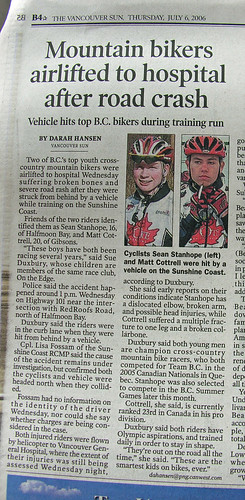
Accident HWY 101 Sunshine Coast Highway
http://duaneburnett.blogspot.com/2010/06/accident-hwy-101-sunshine-coast-highway.html
In that article I referred to the horrible accident where a vehicle wiped out two very popular mountain bikers traveling along the side of the highway in Halfmoon Bay putting both boys into the hospital with multiple injuries and pretty much ending their careers as professional mountain bikers.
It is critically important that vehicle drivers be alert for cyclists and motorcycles on the road like when you are opening the door of your parked car.
We all want to encourage green transportation but not when it results in a blood red catastrophe. These are often our friends and family on the road
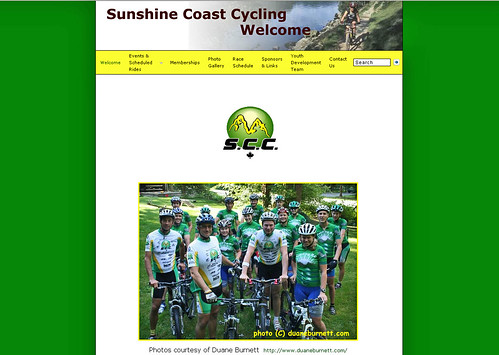
http://www.sunshinecoastcycling.ca/
ICBC, the Insurance Corporation of British Columbia offers several tips to cyclists and motorist on their website which I have reprinted here as a good read.
http://www.icbc.com/road-safety/roadsafety-activities/educators
applying your smart driving skillsCyclists
Cyclists commute to work as well as ride for recreation, so you can expect to see them on the road at any time of the day or night. Be aware that bicycle riders have the same rights and responsibilities on the road as drivers. Observe carefully at all times. Cyclists, like pedestrians, are vulnerable.
Be especially careful near children on bicycles. Children are used to adults watching out for them, so they tend to be unaware of danger. They also have poor peripheral vision, and often find it hard to judge the speed and distance of oncoming vehicles. They may not know the traffic rules or how much room it takes vehicles to stop.
see
Shoulder check — shoulder checking is important because bicycles and riders are narrow and can easily be hidden in your blind spot. Make sure you shoulder check before you:
+ open your door to get out of your vehicle. Check your side mirror as well. One of the most common causes of crashes involving cyclists is drivers who swing their doors open without checking.
+ pull away from the curb
+ move to the right.
+ Pay attention at night — observe carefully, especially for bicycles coming in from side streets. Some cyclists may not have lights, reflectors or reflective gear.
+ Be careful when passing — before you pass another vehicle, make sure you check for oncoming cyclists and cyclists in front of the vehicle you are passing.
Scan at intersections — be especially careful to:
+ Shoulder check for bicycles before turning right.
+ Watch out for a cyclist ahead waiting to turn left if you’re driving straight through.
+ Check carefully for oncoming cyclists before making a left turn.
+ Check carefully for cyclists crossing the road when coming to a place where a bicycle trail meets with a road.
+Be aware that a cyclist riding along the through road could be approaching faster than you think.
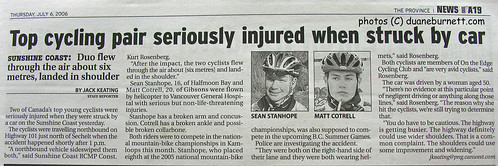
thinkKnow the rules — cyclists follow the same rules and regulations as drivers.
+ Yield to cyclists as you would to any other vehicle. If you have the right-of-way at an intersection, proceed if it is safe. A cyclist will expect you to follow the rules of the road.
+ Be aware that cyclists don’t always stay on the right. To make a left turn, for instance, they need to move over to the left lane. If the lane is narrow, or if there is glass or a pothole on the right, a cyclist has the right to move out toward the middle for safety.
+ Pay attention to bicycle lanes. For more information about these lanes, see chapter 4, rules of the road.
doSpace margins
Allow following distance — allow plenty of following distance.
You need to be able to avoid hitting a cyclist who falls. Cyclists who wobble are probably inexperienced and are more likely to fall than experienced cyclists. Give them even more space than usual.
Allow side margins — a significant number of crashes involving cyclists result from side-swiping. Make sure there is enough space if you want to pass a cyclist. On a narrow road, wait for a clear, straight stretch that will allow you to pull out and give the cyclist room.
Remember, you are allowed to cross a single solid yellow line when passing a cyclist, provided you can do it safely. On a multi-lane road, change lanes rather than risk crowding the cyclist.
Even if you pull just
slightly into another lane
to pass, you are changing
lanes. Remember to
mirror check, signal and
shoulder check.
Communication
Recognize hand signals — understand the hand signals that cyclists use. A cyclist may signal a right turn by extending the right arm straight out.
Make eye contact — a cyclist often uses eye contact to communicate. Make eye contact if you can. She or he is probably trying to anticipate your next move.
Avoid honking your horn — don’t honk your horn at a cyclist unless you need to give a warning. A loud honk could startle a cyclist and even cause a fall.
Strategies: being a safe cyclist
If you are a cyclist, you’re responsible for sharing the road in a way that keeps you and others safe.
Be predictable. Cyclists are more predictable if they follow the rules of the road.
Be visible. Because bicycles are narrow, you need to work at making yourself visible. Wear bright or reflective clothing, especially in the dark or in poor weather.
Position yourself so drivers can see you. Avoid riding in blind spots.
Ride defensively. Think and look well ahead. Be assertive, but remember that a conflict between a cyclist and a motor vehicle usually results in injury to the cyclist.
Ride legally.
In B.C., you must wear an approved bicycle helmet. If you ride at night, your bicycle must be equipped with a front white headlight visible at 150 metres, and have a rear red light and a red rear reflector.
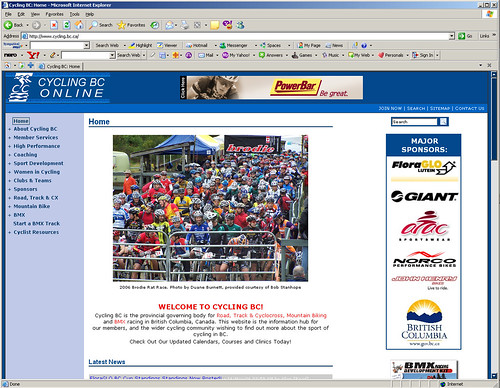
Cycling BC website features the very popular annual mountain bike race in Roberts Creek, British Columbia, then known as the "Rat Race" (C) Duane Burnett www.cycling.bc.ca
Cyclist Traffic Rules
1. Beware of parked cars
2. Stop for stop signs
3. Look for traffic all ways
4. Slow down and look
5. Yield to traffic before crossing
6. Ride in a straight line
7. Shoulder check before turning
8. Use hand signals to tell other drivers what you’re
going to do
9. Ride on right hand side
10. Turn with care
Road Hazards can include:
■ road surfaces: railroad tracks, gravel, water/
mud, snow/ice, oil
■ bumps: driveway entrances, rocks, debris,
sewer covers, lane markers
■ holes: drain covers, depressions in
pavement, metal covers, drain grates
■ sharp objects: glass, rocks, nails, wire,
metal pieces
■ intersections
■ animals
Your Bike Injury Fact Sheet*
Bike injuries in childhood are common and potentially disastrous
The facts
■ Biking is the most popular outdoor activity among young Canadians. Between 86% and 90% of children aged 10 to 14 are bicyclists.
■ More than 150 Canadians die each year from bike injuries. Children aged 5 to 14
account for about half of these deaths.
■ Every year, over 50,000 children are seriously injured in bike related mishaps.
■ Almost half of all the children injured are under 10 years old and 25% are under 7.
■ Eighty-five per cent of bike injuries in childhood do not involve a motor vehicle.
■ The vast majority of children who are involved in bike mishaps (85%) are within six blocks of home.
■ The human skull can be shattered by an impact of 7 – 10 km/h, and children’s skulls are more vulnerable than those of adults.
■ A fall from 2 feet (60cm) can cause permanent brain damage; a fall at a speed of
20 km/h can result in death.
■ Head injuries account for 75% of all deaths from bike injuries.
■ Cycling mishaps are the leading cause of hospital admissions for head injury in
children.
■ Survivors with brain injury may suffer seizures, intellectual and memory impairment, and personality changes.
■ The lifetime costs for a head-injured Canadian — including intensive care, long-term hospital costs, lifetime care and support at home — are estimated to be in the range of $1 – $1.5 million.
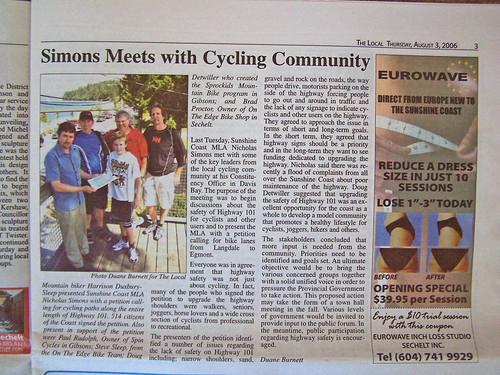
Wearing a bicycle helmet reduces the risk
of head injury by up to 85%,
and the risk of brain injury by 88%.
Thanks to ICBC for putting together this excellent educational information.
Please remember to share the road and enjoy the beautiful Sunshine Coast for your cycling tour!
Thanks so much for reading my blogspot articles, all your likes, suggestions, comments and feedback. Best Wishes!!!! Duane Burnett
It's Always A Good Day on the Sunshine Coast! Duane
http://duaneburnett.com
http://duaneburnett.blogspot.com
http://twitter.com/duaneburnett
Duane's Facebook Profile
http://www.facebook.com/profile.php?id=570266071
Duane's Facebook Fan Page
http://www.facebook.com/pages/Duane-Burnett/132243609016?ref=ts
Sunshine Coast BC Canada facebook FAN PAGE
http://www.facebook.com/pages/Sunshine-Coast-BC-Canada/109315035764459
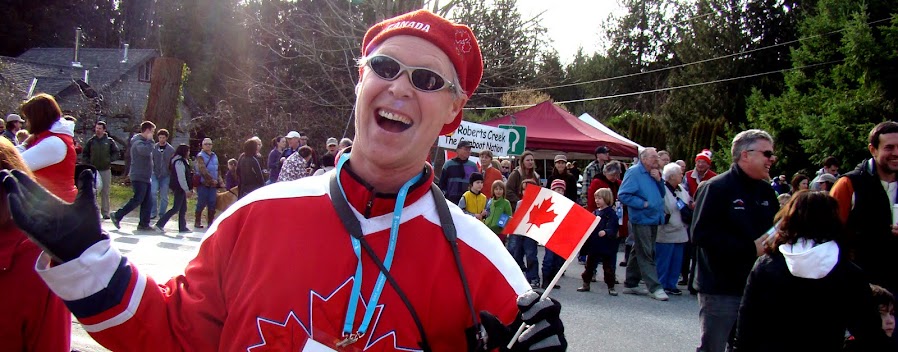
Hey we’re so happy of this new things happening to us now were living and very satisfied for almost 2 years with my wife and the people here are nice, and were living now near to the coast it’s a good investment to us it’s like a package to me property sunshine coast…..
ReplyDelete